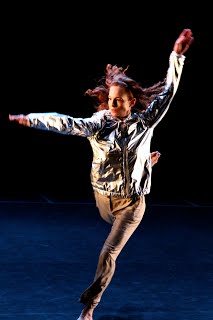Solo, Deluxe Version (2012)
Choreography: Jodi Melnick
Performers: Jodi Melnick, Hristoula Harakas, Jon Kinzel, Stuart Shugg
Lighting Design: Joe Levasseur
Sound: Steve Reker and the band People Get Ready
Notes by Will Rawls:
The Promise of Movement
Jodi Melnick is a dancer whose movements are exquisite in every sense of the word: intricate, perceptive, discriminating, crafted, virtuosic, delicate and exemplary. Her career comprises impressive and memorable appearances with Mikhail Baryshnikov, John Jasperse, Vicky Schick, Twyla Tharp and for tonight’s program, a choreographic collaboration with Trisha Brown. In my mind she has attained a kind of pedigree, a depth of experience, a sensitivity and elocution in her physicality that are utterly non-transferrable. She is one of a kind, which is also why the form of the solo seems so suited to her. It is a form that proposes an intimate rendezvous with the dancer herself and an expansive encounter with the language of dance.
With any work of fine craftsmanship, Melnick’s dancing evinces a sort of tunnel vision – other examples are thrown into relief by comparison and also momentarily shifted to the periphery. She is versed in a broad range of dance idioms, from the anatomically, near-surgically precise to the neo-classically linear to the behaviorally astute and pedestrian. No single work of choreography could easily reconcile these vocabularies, and instead, Melnick tends to channel them into a collaborative and changeable palette, as one might present a spread of complementary delicacies from various corners of the globe, or better
yet, from various corners of New York City. Like any multi-course meal, the pleasure and drama are located in the sequencing of events, in the presentation, in the bravado or understatement that is particular to each recipe. Melnick’s acute sense of timing and idiosyncratic phrasing renders these distinct vocabularies into evocative statements that are her own, revealing not only her history of training but also her lucid performative instincts. And these instincts are the final coup de grace of the exquisite; they formulate the compass that leads the artist to move beyond technique and respect the rigor of her own impulses.
Obeying an impulse also requires a kind of restraint – the spaces between impulses, actions and stillness grow into phrasing. Because Melnick does not work from a pre-determined notion of what her dance will mean, the spectator must rely on the interplay of Melnick’s impulses to construct both the form and the content of what is emerging. Consequently, in the moment of performance, form and content are not so separate, the act of choreography is elided into the act of dancing, the nuances of expression circulate not in passionate displays but in fluctuating gestures and breaths, and the preeminence of a dramatic arc gives way to something more like a sentient, kinetic labyrinth. This can be a poignant experience to behold, perhaps because there is not necessarily a clear path to the center of the piece, or back out again; and Melnick is more aware of his than anyone in the room. There are no guarantees, only the now. Mae West once said, “An ounce of performance is worth pounds of
promises.” Aside from an allusion to the ineluctable covenant between performer and audience, this statement also valorizes what is so complex and so directly affecting about a performance. In Melnick’s case, the promise of mountains of technique and years of experience give way to the promise of an immeasurable gesture of self. More simply put, actions speak louder than words.
Solos, whether or not they carry a story along with them, tend to be an indelible portrait of the performer. In Solo, Deluxe Version, Melnick has invited three fantastic dancers to create and perform the work with her. Considering this, I have to qualify my earlier statement about the singularity of the exquisite – with such excellent dancers as Hristoula Harakas, Jon Kinzel and Stuart Shugg in the mix, Melnick-tunnel-vision will be hard to maintain. Melnick shares a strong bond with each and has generated the material for this piece from experiences they have shared. They are what make this solo a deluxe version. Harakas, Kinzel and Shugg operate as soloists, while at the same time the sheer excellence of their dancing throws
Melnick’s own excellence into relief, the way rare extracts of an uncanny perfume recombine into an even finer ensemble; Melnick’s dancing becomes the top note and her choreography the dispersive breeze. Another thought about relief: it functions in a sculptural sense of physical counterpoint and structural complement, but here, relief also works in the sense of companionship. If this dance is a labyrinth, then the walls that enclose Melnick are also movable, they are interactive and sympathetic, attuned and forgiving, sentient and kinetic, here and gone again. Their presence in the work ensures a mobile and collective promise, phrased just so.


